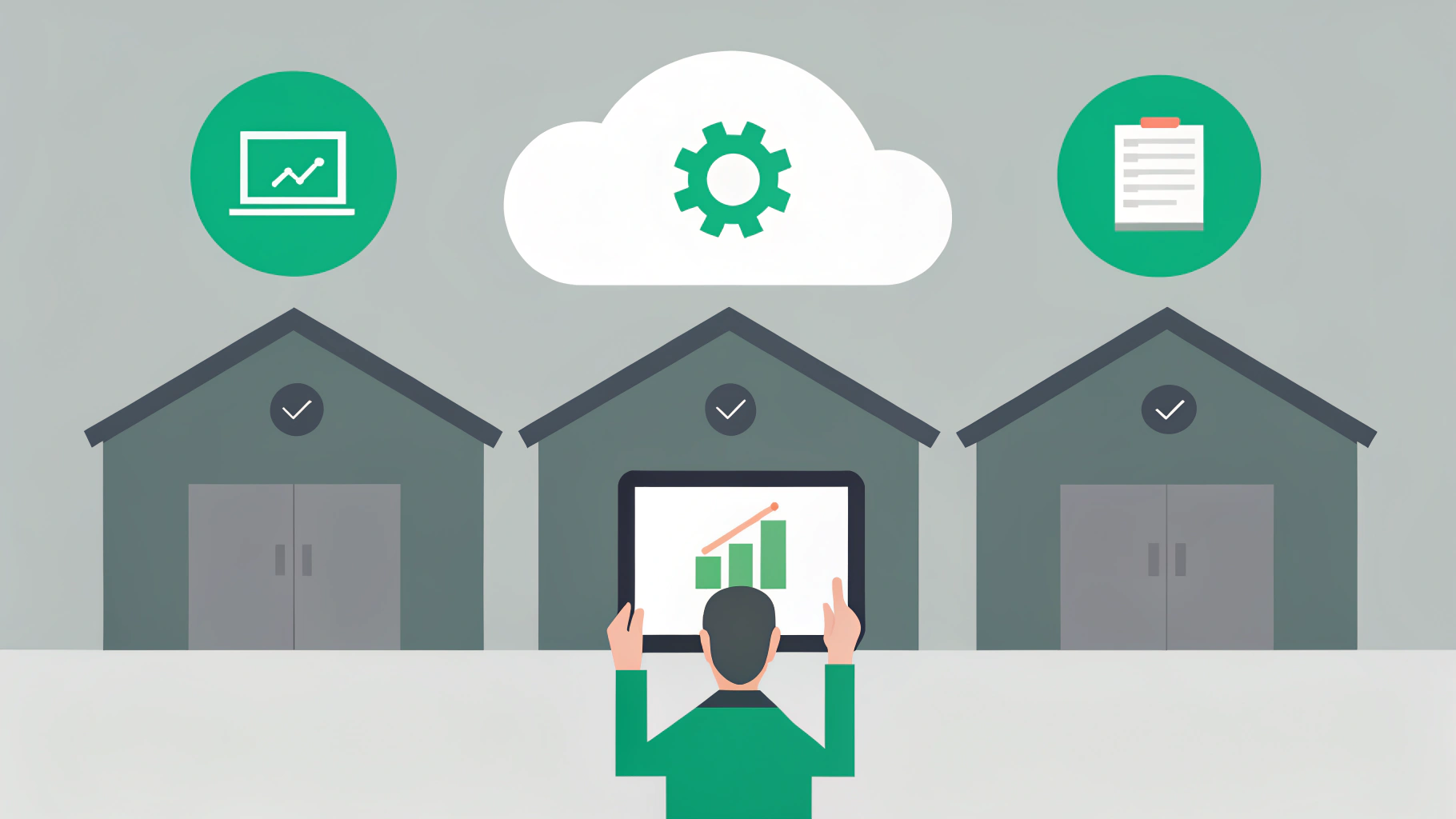Introduction
The distribution landscape is evolving rapidly, creating an urgent need for efficient operational systems. Distributors are on the lookout for ways to boost productivity and streamline processes, and cloud-based ERP solutions offer a significant opportunity for transformation. This article explores the ten critical steps of the ERP implementation life cycle, specifically designed for distributors, and highlights the strategic advantages of embracing modern technology. Yet, with the promise of enhanced efficiency comes the challenge of navigating potential pitfalls. What key considerations can make or break a successful ERP transition?
10X ERP: Streamline Your ERP Implementation with Cloud-Based Solutions
10X ERP revolutionizes the ERP implementation life cycle for distributors by harnessing the power of cloud technology. This cutting-edge approach enables real-time data access, empowering businesses to make swift, informed decisions. With a user-friendly interface that’s accessible from any web browser, 10X ERP boosts operational efficiency, allowing distributors to manage their operations seamlessly from any location.
The cloud-based architecture of 10X ERP not only supports scalability but also significantly reduces the complexity often associated with traditional ERP solutions. As organizations increasingly focus on digital transformation, cloud ERP solutions are expected to dominate the market, projected to account for 60% of total ERP deployments by 2025. This shift is driven by the need for adaptability, integration, and features like customizable permissions and roles, which are essential for growing distributors aiming to optimize processes and enhance productivity.
The ERP implementation life cycle of successful cloud ERP solutions has demonstrated substantial benefits, including:
- A 30% increase in ROI within three years
- A 70% reduction in manual errors, leading to improved operational accuracy
Furthermore, 89% of ERP users report efficiency improvements as a primary advantage, highlighting the effectiveness of cloud ERP solutions. As more distributors recognize these benefits, the adoption of cloud technology in ERP solutions is expected to accelerate, positioning 10X ERP as a strategic choice for those looking to thrive in a competitive landscape.
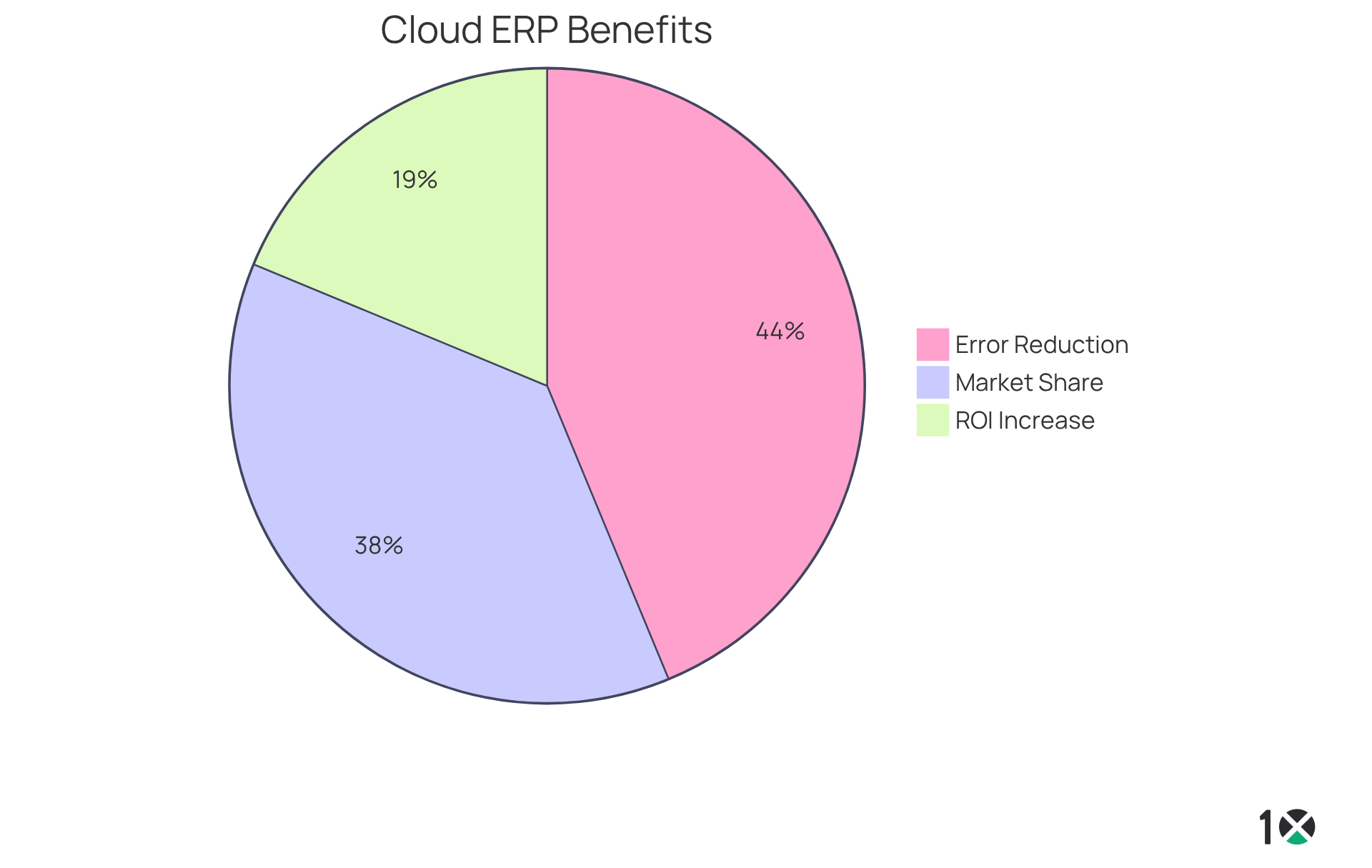
Define Your Goals: Establish Clear Objectives During the Planning Phase
Establishing specific, measurable, achievable, relevant, and time-bound (SMART) goals during the planning phase is crucial for the ERP implementation life cycle to be successful. This clarity not only aligns the project with the overall business strategy but also ensures that all stakeholders are aware of the expected outcomes. For instance, distributors often aim to reduce inventory holding costs by 20-30% within the first year of ERP adoption. This target is supported by the fact that organizations implementing ERP typically achieve significant cost reductions.
Expert advice underscores the importance of defining these objectives early on, as it enhances focus and drives accountability throughout the project. Moreover, aligning the ERP implementation life cycle with business strategy is essential, as it ensures that the implementation supports broader organizational objectives, ultimately leading to improved operational efficiency and profitability.
With 10X ERP’s cloud-based solutions, distributors can leverage real-time data processing to monitor inventory levels and make informed decisions. This capability supports their goal of cost reduction and operational efficiency. Additionally, 10X ERP offers robust support mechanisms and security practices that further enhance the implementation, ensuring a secure and efficient transition to the new system.
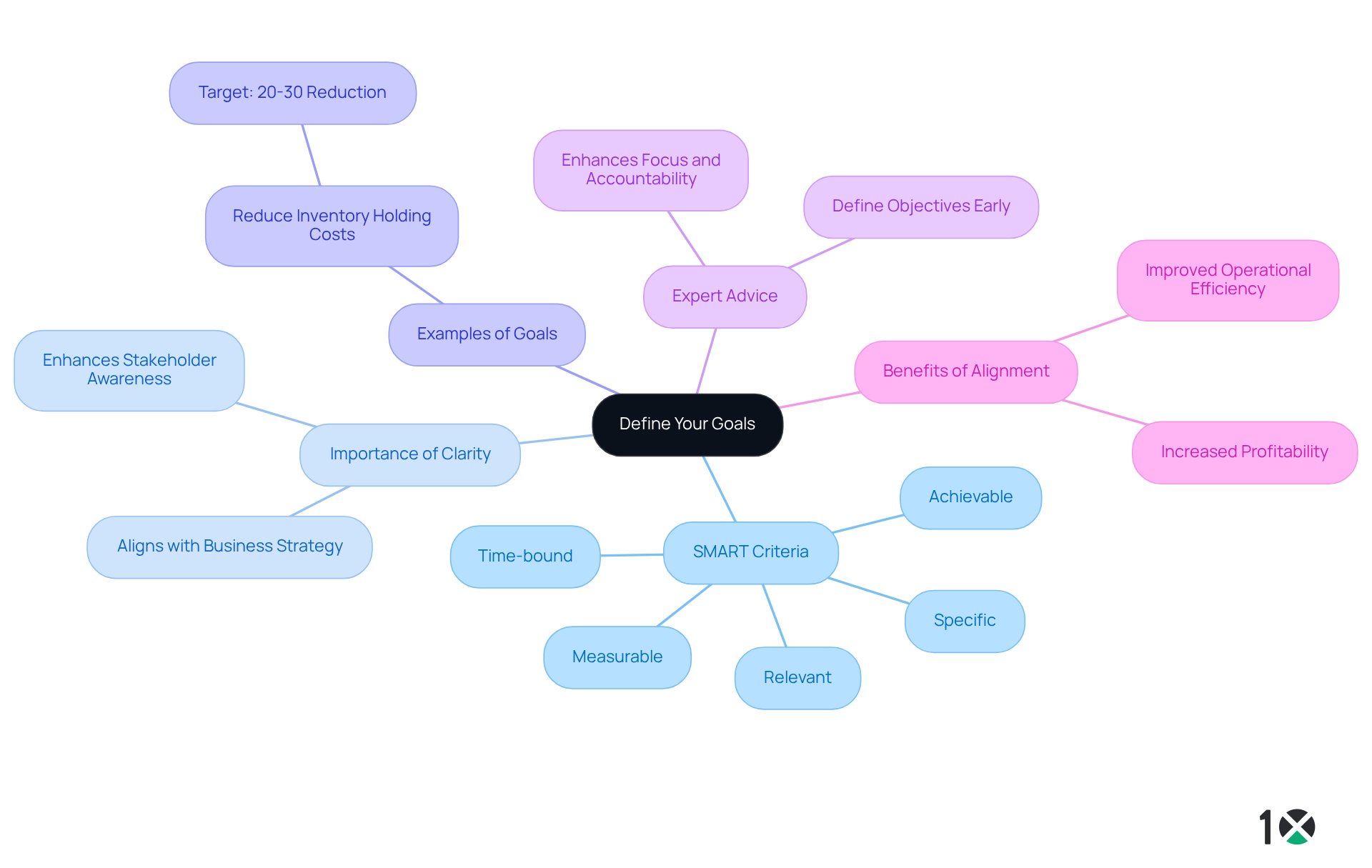
Gather Requirements: Identify Key Functionalities for Your ERP System
Gathering requirements stands as a critical first step in ERP implementation. It necessitates thorough consultation with various stakeholders to pinpoint essential functionalities. Distributors often prioritize features such as:
- Advanced inventory management
- Robust accounting
- Comprehensive reporting capabilities
For instance, effective inventory tracking is crucial for managing multiple warehouses, enabling real-time visibility and operational efficiency. Did you know that 67% of buying companies regard inventory and distribution functions as essential criteria for ERP assessment? This statistic highlights their significance in the selection process. Furthermore, organizations that implement these functionalities can expect a 30% ROI increase within three years, underscoring their value.
Recording these requirements not only assists in choosing the appropriate ERP solution but also ensures consistency with the ERP implementation life cycle and current business operations. This ultimately improves the chances of a successful implementation. However, it’s important to be aware that 47% of ERP projects exceed their original timelines. This statistic emphasizes the need for careful planning during the requirements gathering phase.

Select the Right System: Evaluate ERP Options Based on Your Needs
Choosing the right ERP solution is crucial for distributors. This decision should be guided by specific business needs, budget constraints, and scalability requirements. Key considerations include:
- Integration capabilities with existing software
- User-friendliness
- Level of vendor support available
Notably, 67% of purchasing firms identify inventory and distribution functions as critical ERP capabilities, underscoring the necessity for robust inventory management features.
To gain deeper insights into the performance and usability of the platform, conducting product demonstrations and gathering feedback from existing clients is invaluable. A distributor may prioritize an ERP that seamlessly integrates with their e-commerce platform, ensuring a cohesive operational flow. Furthermore, with 53% of companies adopting cloud-based ERP solutions, the adaptability and scalability offered by these platforms can significantly enhance operational efficiency.
By focusing on these factors, distributors can make informed decisions that align with their strategic goals and operational needs. This approach not only streamlines processes but also positions them for future growth.

Install the System: Execute a Smooth ERP Installation Process
Executing a smooth ERP installation as part of the ERP implementation life cycle with 10X ERP requires meticulous planning and coordination with the vendor. Establishing a clear timeline, allocating resources effectively, and ensuring all necessary hardware and software requirements are met are crucial steps. Communication with stakeholders is vital during this phase to keep everyone informed of progress and any potential disruptions. For instance, scheduling the installation during off-peak hours can significantly minimize the impact on daily operations.
Statistics indicate that a staggering 50% of the ERP implementation life cycle fails on the first attempt, often due to challenges such as poor project management, cost overruns, and internal resistance. To mitigate these risks, organizations must adopt a proactive approach that includes thorough planning and active stakeholder engagement during the ERP implementation life cycle. Expert advice underscores the importance of involving users in prototyping activities before User Acceptance Testing (UAT), which can lead to more favorable outcomes. Furthermore, having contingencies in place for potential delays is essential, as implementation timelines can extend by up to 30% longer than anticipated. The data migration phase can consume as much as 30% of total project resources, highlighting the necessity for careful resource allocation.
By prioritizing these strategies, distributors can significantly enhance their chances of success throughout the ERP implementation life cycle with 10X ERP. This system is specifically designed to support high transaction volumes and provide real-time data processing, accounting, and inventory management features.
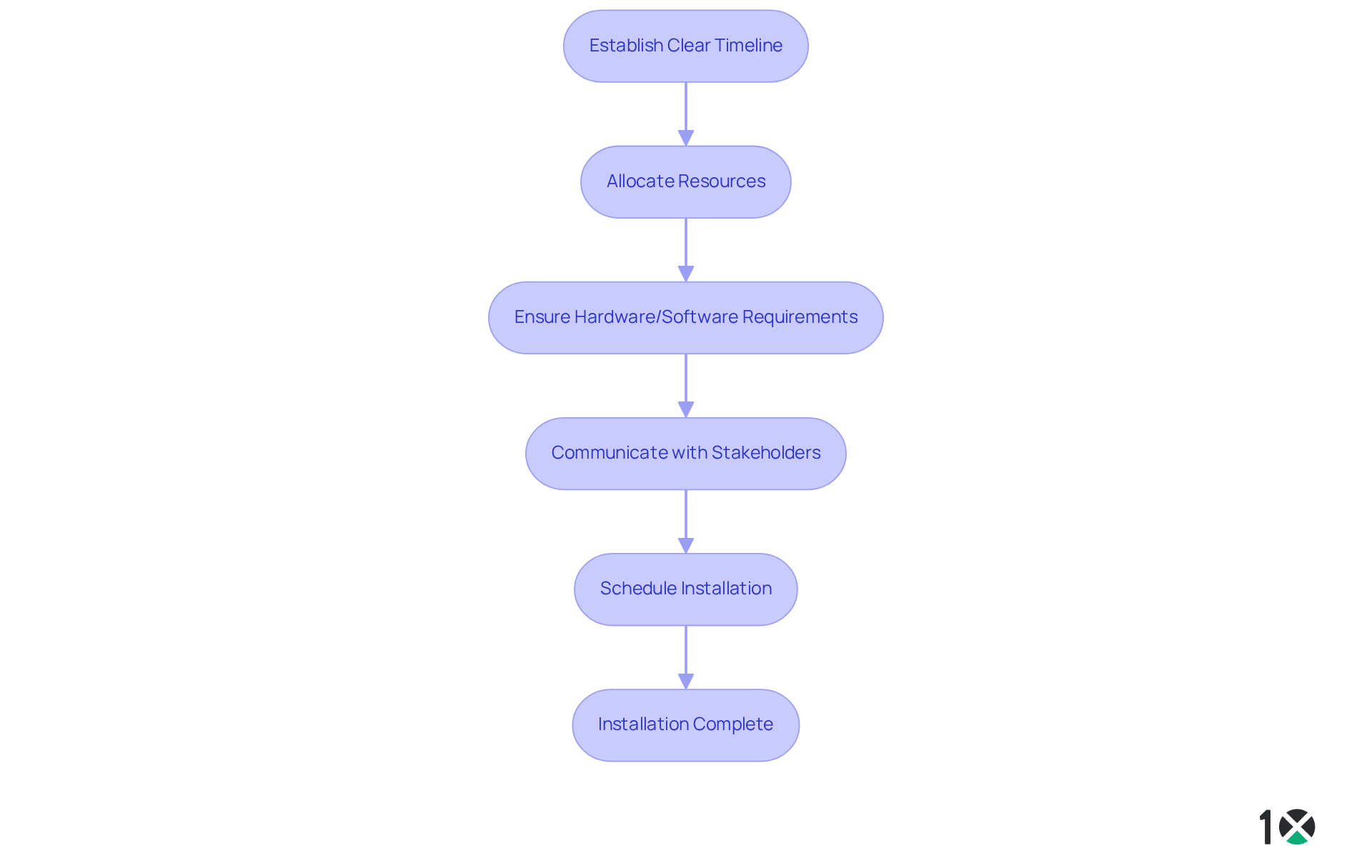
Migrate Data: Ensure Accurate and Secure Data Transfer to the New ERP
Data migration stands as a pivotal phase in transitioning from outdated platforms to a new ERP system, demanding meticulous planning to ensure both accuracy and security. Key steps in this process encompass:
- Data cleansing
- Mapping data fields
- Validating data post-migration
For example, distributors must confirm that all inventory records are accurately transferred, addressing any discrepancies before the platform goes live.
With 10X ERP’s comprehensive cloud-based solution, which provides a seamless experience and transparent pricing, recent advancements in automated data migration tools significantly simplify this task. These tools minimize the risk of errors and enhance efficiency. Yet, common challenges remain; 22% of businesses cite data migration and validation as their primary hurdles in the ERP implementation life cycle. To tackle these issues, organizations should prioritize a robust data migration strategy, ensuring that high-quality, reliable data is migrated to support essential operations like inventory management and financial processing.
By leveraging 10X ERP’s capabilities, including unlimited integrations through modern APIs and lightning-fast performance, businesses can invest in thorough data validation and utilize advanced tools. This approach builds confidence and accelerates the adoption of their new ERP solution. Ultimately, 95% of companies experienced process improvements from ERPs, underscoring the advantages of a well-executed data migration process.
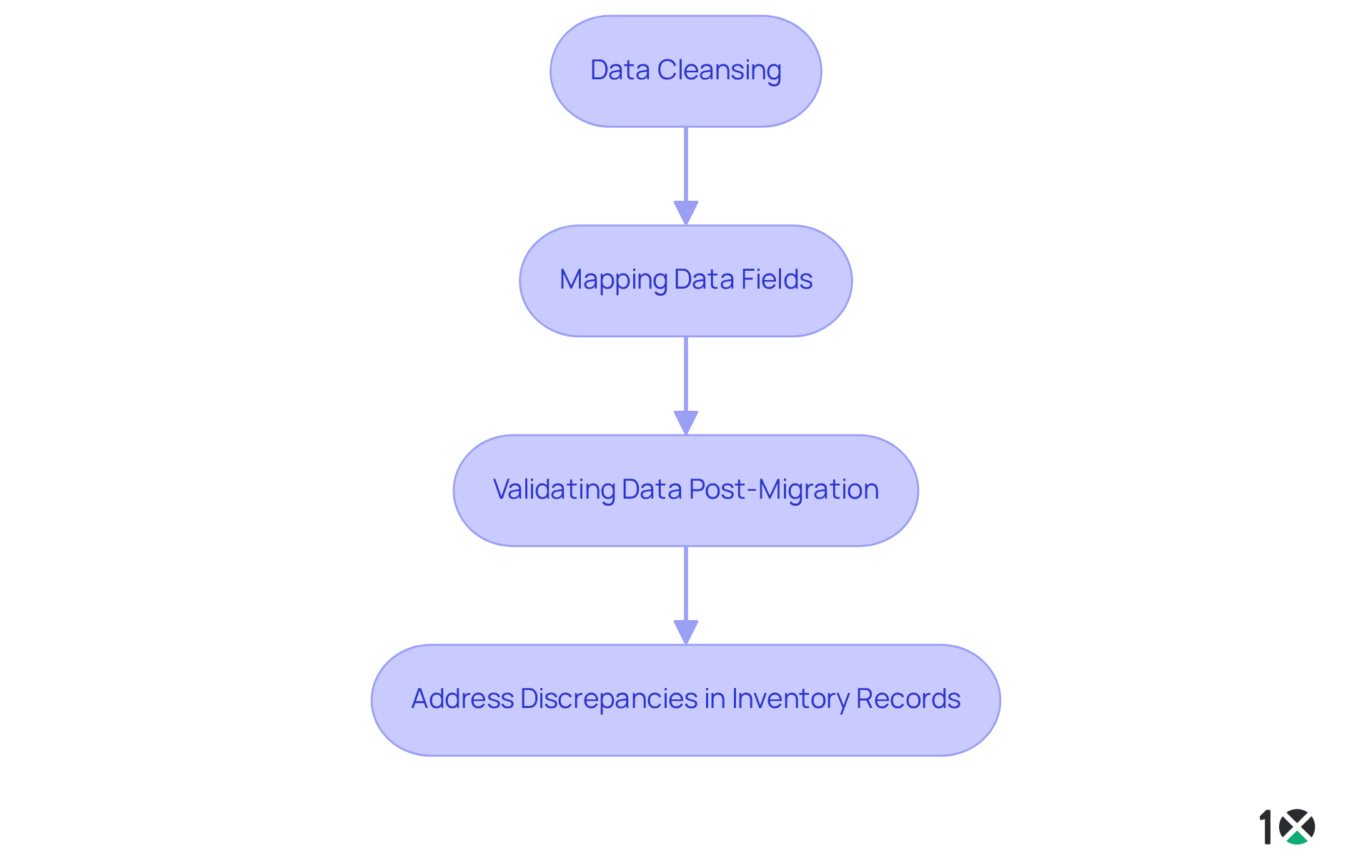
Train Users: Equip Your Team with the Skills to Utilize the ERP Effectively
Training individuals on the new ERP system is essential for successful adoption throughout the ERP implementation life cycle. Role-based training that addresses the unique needs of different groups is crucial. For example, warehouse staff should concentrate on inventory management features, while finance teams need in-depth knowledge of accounting functionalities. Research shows that tailored training programs can lead to a remarkable 30% increase in participant proficiency within the first few months. This boost significantly enhances overall productivity and data accuracy.
Moreover, continuous assistance plays a vital role in this process. Providing resources like manuals, help centers, and refresher courses can greatly enhance both confidence and proficiency. Companies that invest in post-training support report a striking 60% reduction in system-related errors, which facilitates smoother operations. Additionally, incorporating training into everyday practices through practical, role-specific activities can improve skill retention and application, ensuring employees are well-prepared to utilize the ERP platform effectively.
As trends evolve, organizations are increasingly adopting blended training approaches that combine various methods to cater to different learning styles. This adaptability not only enhances engagement but also leads to higher satisfaction levels among participants. On average, the time required for effective ERP training can vary during the ERP implementation life cycle in distribution companies. However, structured programs typically yield faster adoption rates, with some organizations experiencing up to 70% quicker integration when comprehensive training is provided.
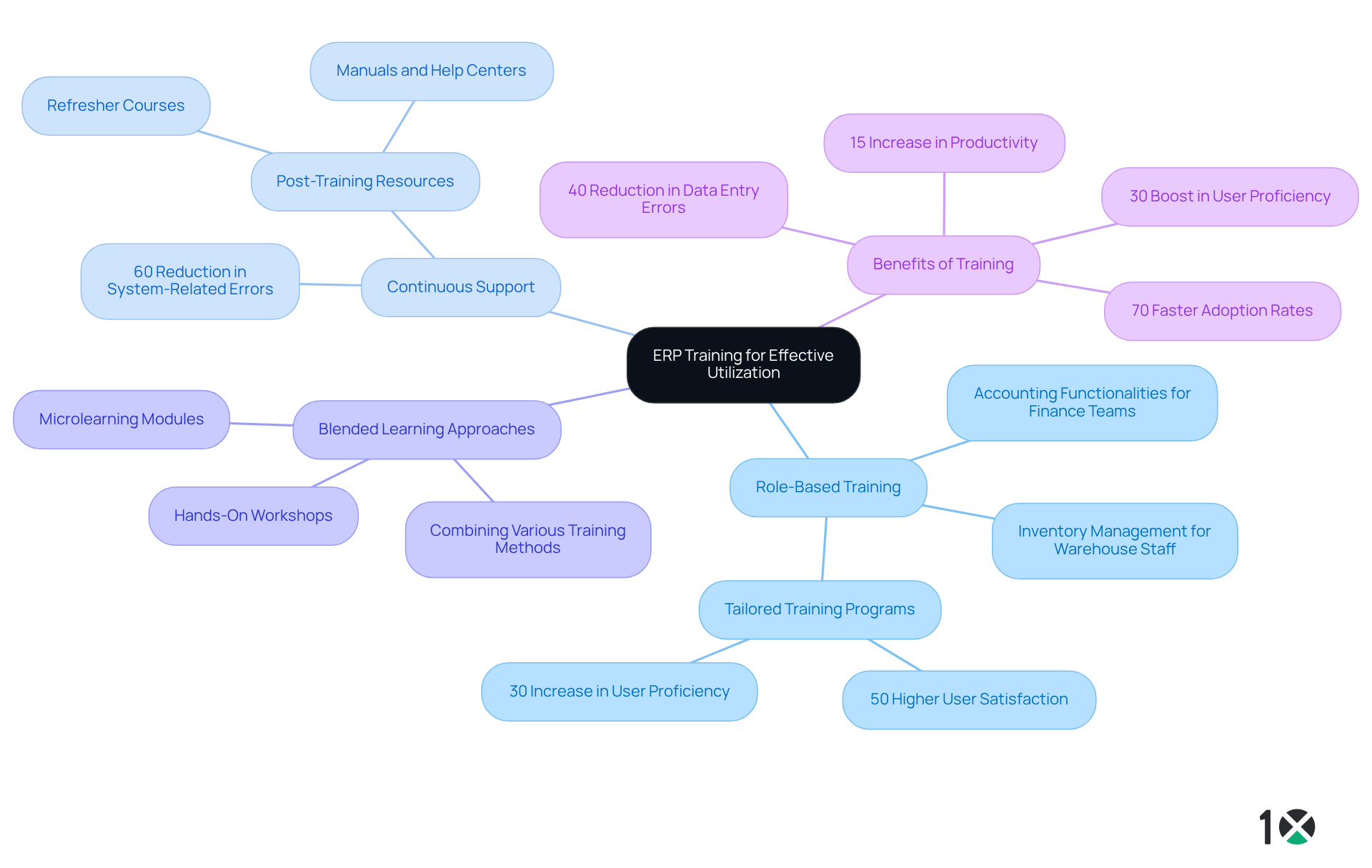
Test the System: Conduct Thorough Testing to Ensure Functionality
Thorough testing of the ERP platform is essential to ensure that all functionalities operate as intended. This process encompasses various testing methods, including:
- Unit testing
- Integration testing
- Acceptance testing (UAT)
Engaging end-users during this phase is particularly advantageous, as it yields valuable feedback and helps pinpoint issues that may require resolution. For instance, a distributor might assess the order processing workflow to confirm its seamless integration with inventory management and accounting modules.
This comprehensive approach not only bolsters reliability but also tailors the ERP solution to meet the specific needs of the business, ultimately enhancing operational efficiency. Recent trends reveal that 71% of companies believe decisions are delayed when ERP data is unavailable, highlighting the critical need for effective testing to guarantee timely access to essential information.
Moreover, organizations that prioritize UAT are more likely to see improvements in application performance and adoption rates. This makes UAT an indispensable component of the ERP implementation process. By focusing on thorough testing, businesses can ensure their ERP systems are robust, reliable, and ready to support their operational goals.
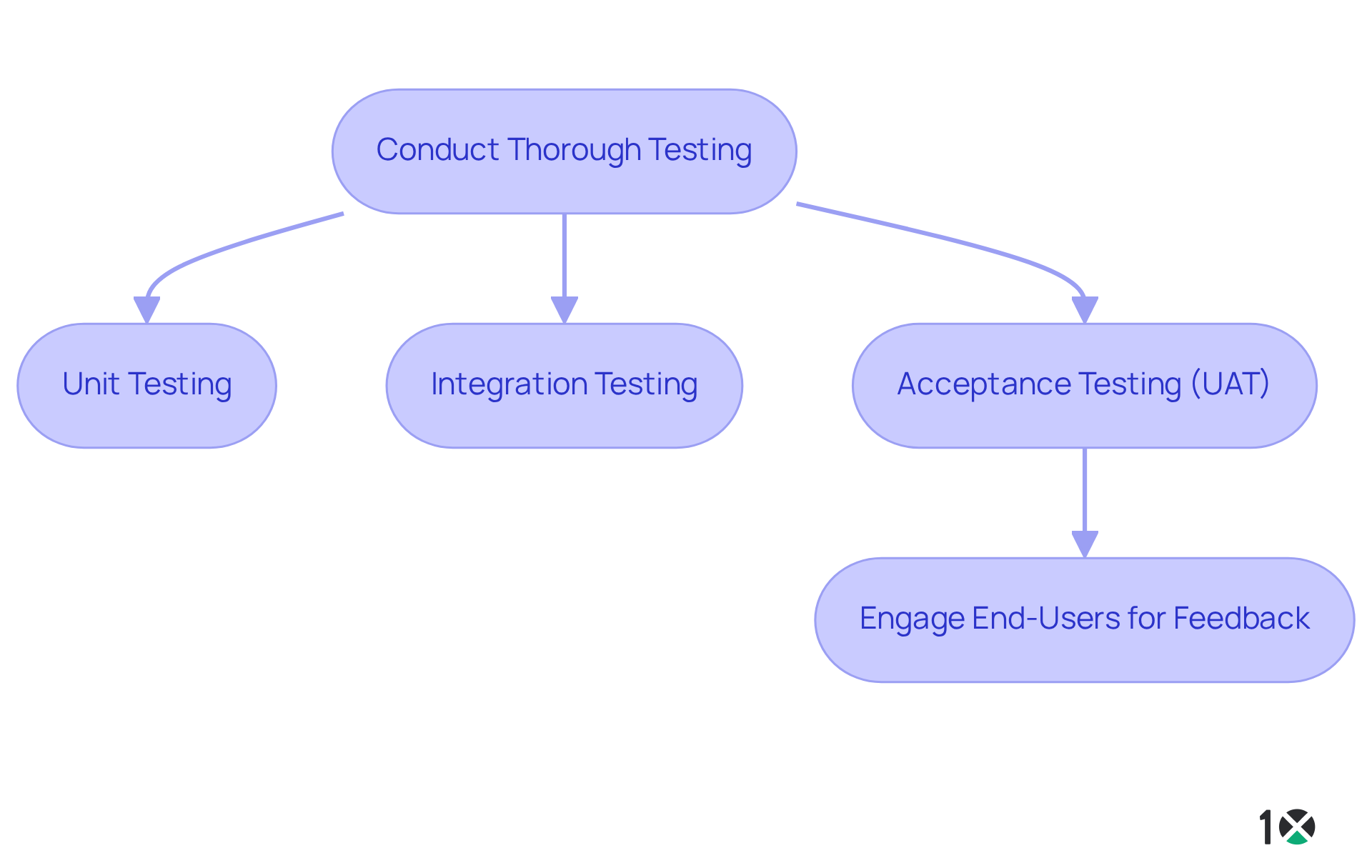
Go Live: Transition to Full Operation with Your New ERP System
The go-live phase represents a pivotal transition in the ERP implementation life cycle, as it moves operations from the legacy system to the new ERP platform. This phase often presents several challenges, such as data migration issues, resistance from individuals, and operational disruptions. Alarmingly, statistics reveal that 50% of ERP implementations fail on the first attempt, frequently due to inadequate project management and unforeseen complexities. To mitigate these risks, a robust go-live strategy is essential.
Effective management of this transition hinges on several key practices:
- Clear Communication: Establishing transparent communication channels with all stakeholders ensures everyone is informed about the changes and expectations.
- Dedicated Support: A dedicated support team available during the initial days of operation can significantly enhance user confidence and address issues promptly. Research shows that organizations with a support framework during go-live report higher satisfaction rates.
- Performance Monitoring: Continuously observing performance allows for quick identification and resolution of any technical issues that may arise, ensuring a smoother transition.
Instances of effective go-live strategies in distribution include phased rollouts, where the ERP solution is deployed in stages across various departments or locations. This approach, favored by 58.5% of companies, allows for adjustments based on initial feedback and reduces the risk of widespread disruption.
Expert advice underscores the importance of change management during this phase. Involving participants early on and providing thorough training can help reduce opposition and foster a favorable mindset towards the new framework. Additionally, organizations should brace for potential operational disruptions, as 51% of companies encounter challenges during the go-live phase.
By focusing on these strategies, businesses can effectively navigate the complexities of the go-live phase, setting the stage for a successful ERP implementation life cycle that enhances operational efficiency and drives growth.
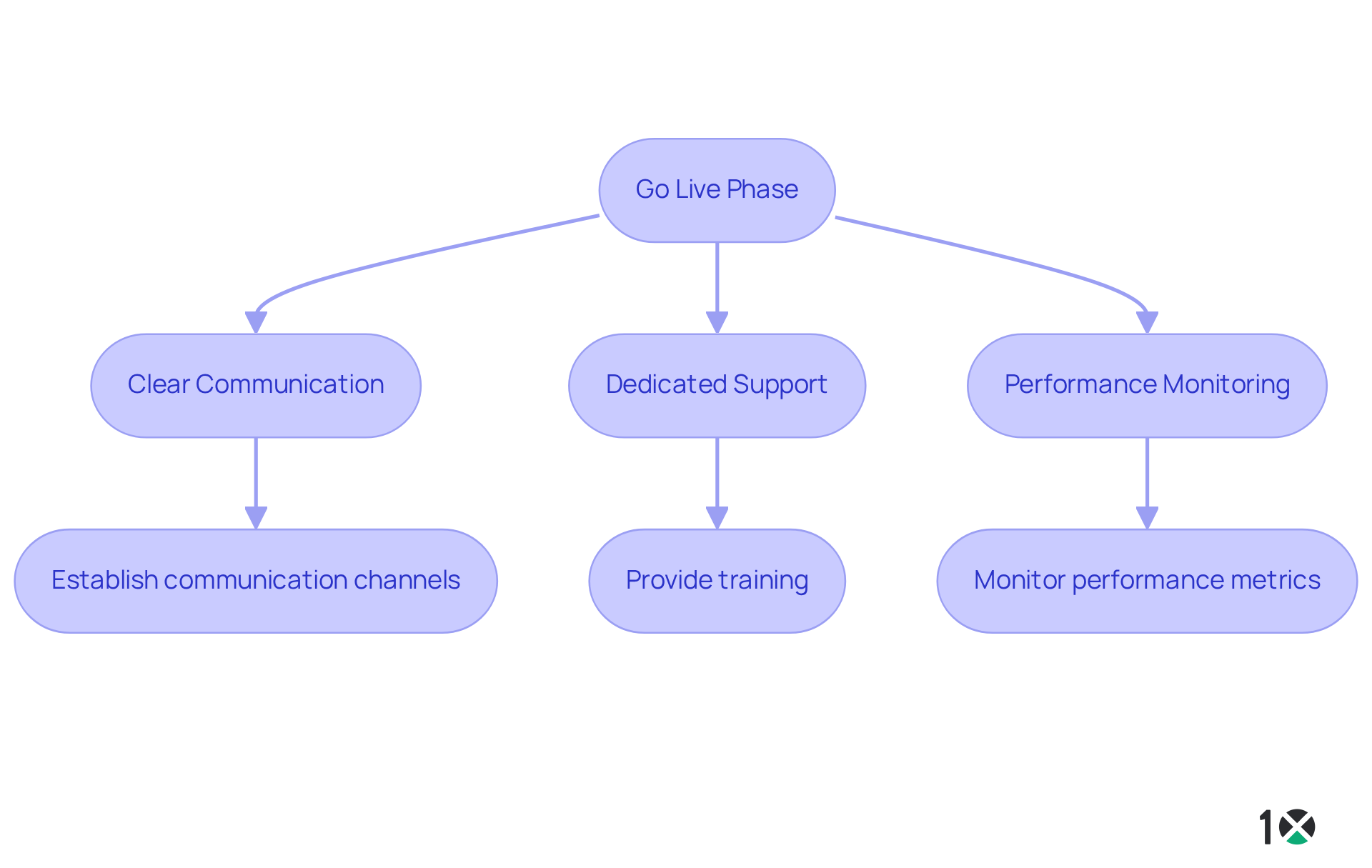
Implement Continuous Improvement: Gather Feedback for Ongoing ERP Enhancements
Establishing a continuous enhancement procedure for the ERP platform is essential after the ERP implementation life cycle. This process involves systematically gathering feedback from users to evaluate their experiences and identify opportunities for improvement. Regular surveys and feedback sessions can uncover usability challenges and desired features. By involving participants in the ERP implementation life cycle, organizations cultivate a sense of ownership and ensure that the ERP system adapts to changing business needs, enhancing its efficiency and value.
10X ERP significantly improves this workflow through its seamless experience and in-app training assistance, making it easier for users to provide feedback. Additionally, the use of analytics cookies allows 10X ERP to understand service usage patterns, enabling informed enhancements based on user interactions. Statistics reveal that 78% of organizations experience increased productivity through ERP systems. With 10X ERP’s rapid onboarding and transparent pricing, distributors can maximize their ERP effectiveness.
Incorporating expert insights on feedback collection streamlines this process, allowing distributors to implement changes that resonate with user needs and drive operational excellence. As Benjamin Franklin wisely stated, ‘Without continual growth and progress, such words as improvement, achievement, and success have no meaning.’ This reinforces the necessity for ongoing improvement throughout the ERP implementation life cycle.

Conclusion
The ERP implementation life cycle for distributors represents a transformative journey. When executed effectively, it can lead to significant operational enhancements and competitive advantages. By leveraging cloud-based solutions like 10X ERP, distributors can streamline their processes, ensuring agility and responsiveness to market demands.
This article outlines the key steps in the ERP implementation life cycle, emphasizing the importance of:
- Clear goal-setting
- Thorough requirements gathering
- Careful system selection
Each phase – from installation to user training and testing – plays a critical role in ensuring a successful transition to a new ERP system. Moreover, the significance of continuous improvement post-implementation cannot be overstated; it allows organizations to adapt their systems to evolving needs and maximize their investment.
Ultimately, embracing cloud technology in ERP solutions not only enhances operational efficiency but also positions distributors for growth in an increasingly competitive landscape. By prioritizing best practices and fostering a culture of feedback and improvement, organizations can fully realize the potential of their ERP systems, driving long-term success and sustainability.
Frequently Asked Questions
What is 10X ERP and how does it benefit distributors?
10X ERP is a cloud-based ERP solution that streamlines the ERP implementation life cycle for distributors by providing real-time data access, enhancing operational efficiency, and enabling management from any location through a user-friendly interface.
What advantages does cloud-based architecture offer in 10X ERP?
The cloud-based architecture of 10X ERP supports scalability, reduces complexity, and facilitates adaptability and integration, making it easier for growing distributors to optimize processes and enhance productivity.
What are the expected market trends for cloud ERP solutions?
Cloud ERP solutions are projected to account for 60% of total ERP deployments by 2025, driven by the increasing focus on digital transformation among organizations.
What benefits can organizations expect from implementing 10X ERP?
Organizations can expect a 30% increase in ROI within three years and a 70% reduction in manual errors, leading to improved operational accuracy. Additionally, 89% of ERP users report efficiency improvements as a primary advantage.
Why is it important to define goals during the ERP implementation planning phase?
Establishing specific, measurable, achievable, relevant, and time-bound (SMART) goals during the planning phase aligns the project with the overall business strategy, enhances focus, and drives accountability throughout the project.
What common goals do distributors set when implementing ERP systems?
Distributors often aim to reduce inventory holding costs by 20-30% within the first year of ERP adoption, which is supported by significant cost reductions typically achieved through ERP implementation.
What key functionalities should be identified when gathering requirements for an ERP system?
Key functionalities that distributors often prioritize include advanced inventory management, robust accounting, and comprehensive reporting capabilities.
How important is effective inventory tracking in ERP implementation?
Effective inventory tracking is crucial for managing multiple warehouses and enables real-time visibility and operational efficiency, which are essential for successful ERP implementation.
What challenges do organizations face during the ERP implementation process?
Approximately 47% of ERP projects exceed their original timelines, highlighting the need for careful planning during the requirements gathering phase to improve the chances of successful implementation.
How does 10X ERP enhance the transition to a new system?
10X ERP offers robust support mechanisms and security practices that enhance the implementation process, ensuring a secure and efficient transition to the new system.
